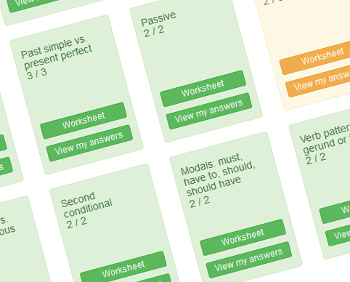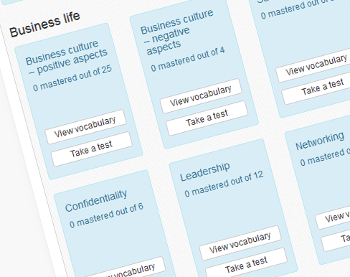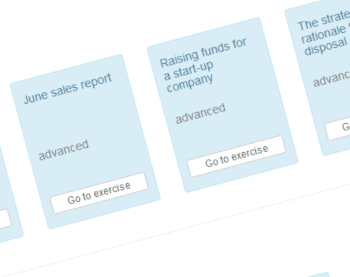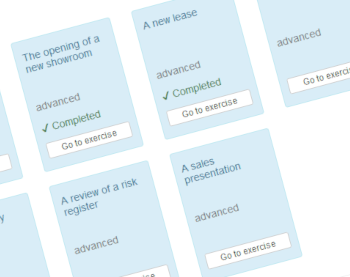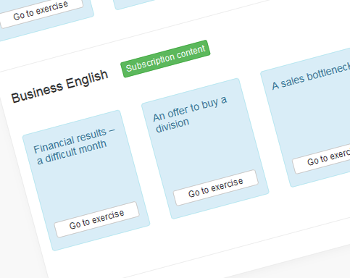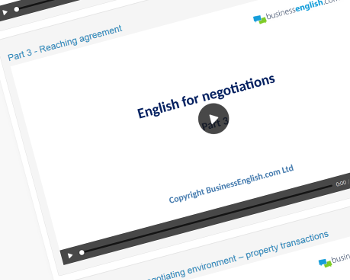El futuro perfecto
(Future perfect)
Introducción
El futuro perfecto se usa para hablar de algo que se realizará, o no, en el futuro.Por ejemplo:
- We are flying tonight. By this time tomorrow, we will have arrived at the hotel and explored the resort.
- If Richard continues working at this pace, he will have finished all his reports long before the rest of us.
- Unless they hurry up, they won't have finished the decorating when we get back.
- How many films will we have seen after this one?
Al igual que con el futuro simple, se puede usar shall en lugar de will con los pronombres personales I y We : es más formal y no es común en el lenguaje cotidiano.
Forma
El futuro perfecto se forma conwill / won´t have + el participio pasado del verbo principal.
Por ejemplo:
|
I
You He / She / It We They |
will have
will not have won't have |
completed | the novel before the end of the year. |
| Will |
I
you he / she / it we they |
have completed | the novel before the end of the year? |
Práctica
.Más práctica
Elija la respuesta correcta para completar la frase: a, b, c ó d..
Create a free Getting Started account
Enlaces relacionados
En los siguientes ejercicios figura el uso de esta estructura gramatical:
También podría interesarle:
- Ejercicios de vocabulario de inglés de negocios
- Lectura Cuenta Pro
- Scenario-based dictation exercises – business English Cuenta Pro
También podría interesarle:
Principiantes
- Pasado simple
- Pasado continuo
- Presente simple
- Presente continuo (presente)
- El presente perfecto
- Los dos futuros “going to” y “will”
- Presente continuo (futuro)
- El imperativo
- Ser o estar “to be”
- Pronombres: sujeto, objeto
- Pronombres: relativos
- Adjetivos y pronombres posesivos
- Adjetivos y pronombres demostrativos
- Lugar básico de los adjetivos
- Preguntas que empiezan con WH (pronombres interrogativos)
- Los artículos: “a, an, the”
- Las preposiciones de tiempo y lugar
- “There is"/"there are” y los cuantificadores
- Las conjunciones “and","or", "but”
- Los comparativos/superlativos (than)
- El condicional cero “if”
- Primer condicional (if)
- Los verbos modales: “can" / "can´t", "could", "will", "shall”
- Patrones de verbos
- Sequence adverbs
Intermedio
- El pasado perfecto
- El pasado simple vs presente perfecto
- El pasado simple vs pasado continuo
- El presente perfecto continuo
- El futuro simple
- El futuro continuo
- La voz pasiva
- El estilo indirecto
- “Used to" / "would”
- El segundo conditional
- El tercer condicional
- Las oraciones de relativo
- Los pronombres reflexivos
- Los verbos modales: must, have to, should, should have
- Patrones verbales: gerundio o infinitivo
- Los adverbios de grado
- El orden de los adjetivos
- Adjetivos acabados en “ed” o “ing”
Gramática
Identifique rápidamente y concéntrese en los problemas de gramática:
- Hojas de actividades y examen de gramática
- Scenario-based grammar exercises
- Grammar additional practice questions
- Práctica de conjugación verbal
- Práctica de los condicionales
Mejore su gramática
Vocabulario
Vocabulary exercises:Amplíe su vocabulario utilizando nuestros tres profesores de vocabulario:
- Práctica de vocabulario de inglés general
- Práctica de vocabulario de inglés de negocios
- Práctica de giros idiomáticos
Aprenda vocabulario
Ejercicios de dictado
Practique sus habilidades de escucha y escritura utilizando nuestros ejercicios de dictado:
- Scenario-based dictation exercises - general English
- Scenario-based dictation exercises - business English
- Dictado: profundizando en la gramática
- Números
Complete los ejercicios de dictado
Lecciones en video
Concéntrese en áreas concretas dentro del inglés de negocios utilizando nuestras lecciones en video:
Reciba una lección por vídeo
